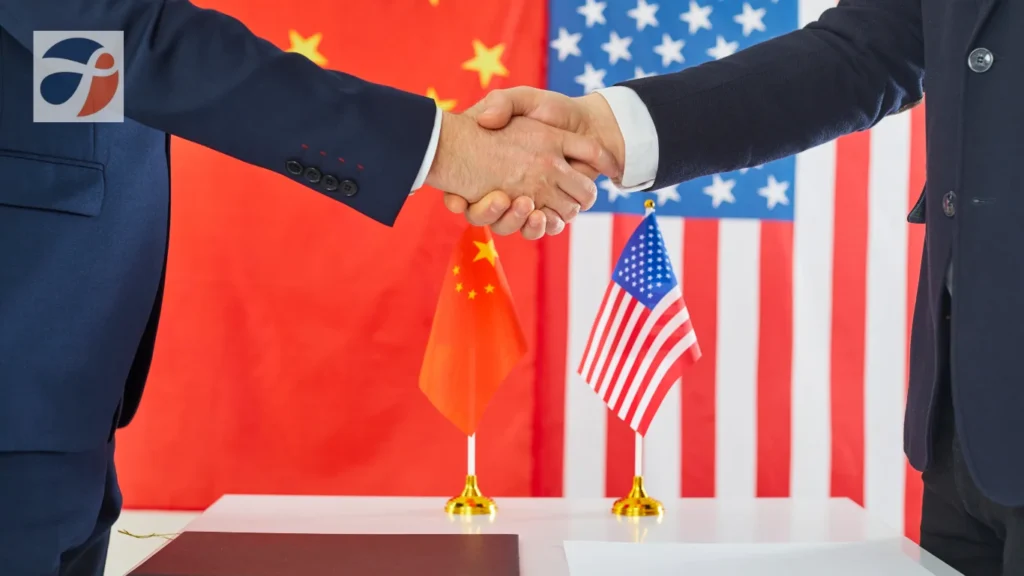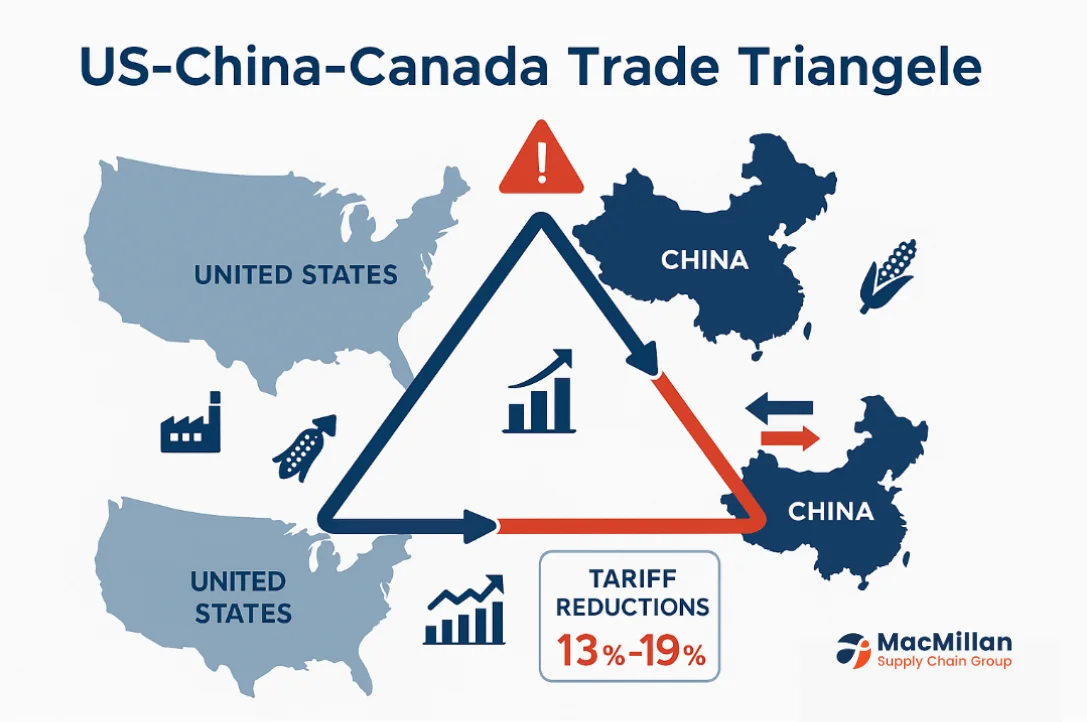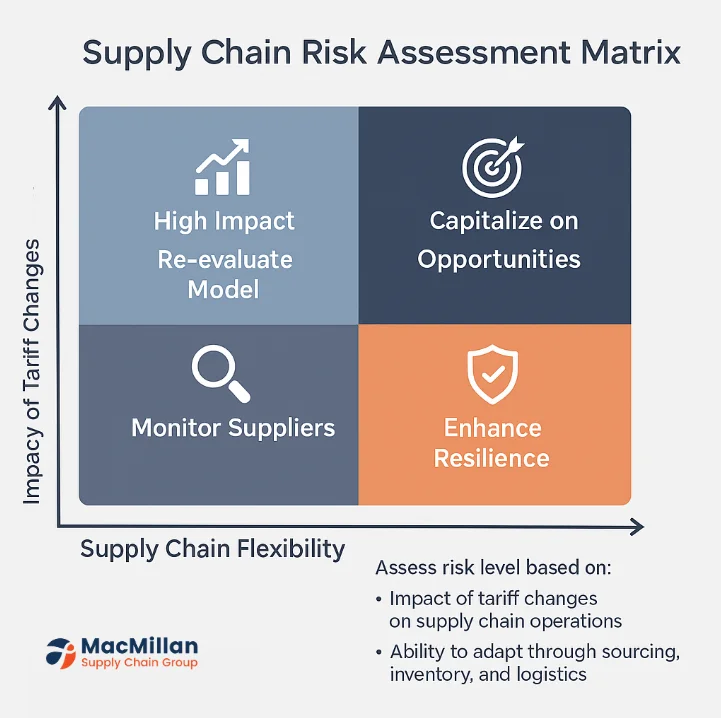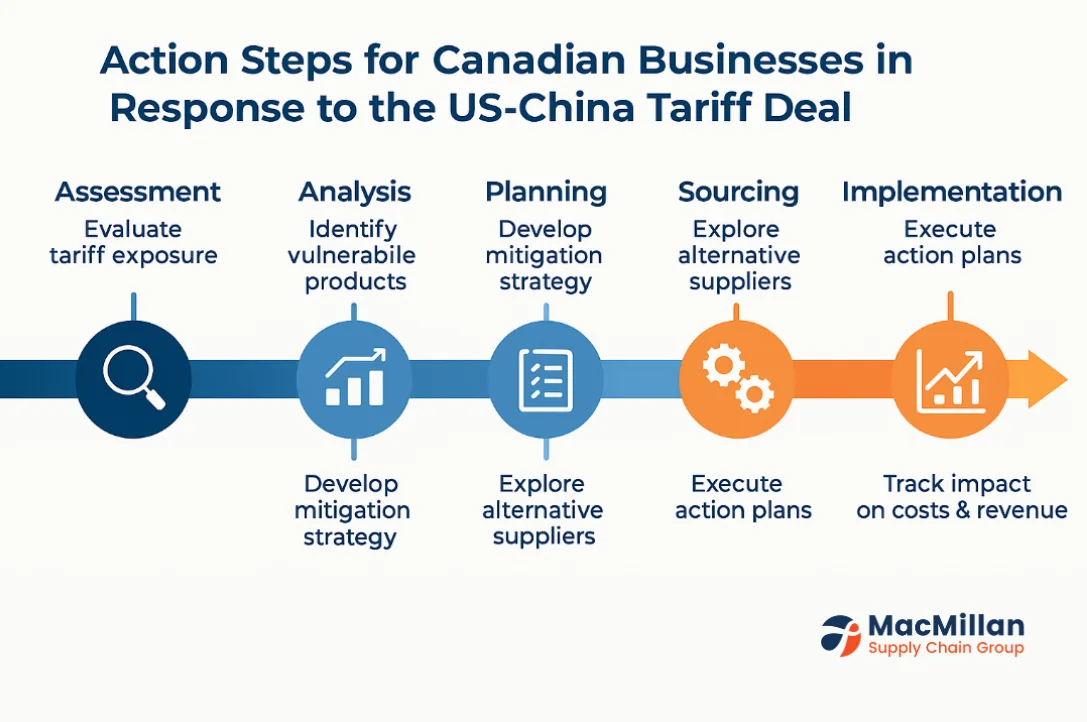Recognizing How the US-China Tariff Deal Affects Canadian Companies
Changes in trade policies by the two biggest economies in the world have an impact that goes well beyond their boundaries. With significant ramifications for Canadian companies and supply chains, the recent US-China tariff deal represents a significant change in the dynamics of global trade. This new agreement seeks to lower tariffs and loosen trade restrictions between these two economic titans following years of rising tensions in the US-China trade war.
However, what does this entail for middle-tier Canadian businesses? What effects will these modifications have on your supply chain’s overall resilience, export prospects, and import strategy? MacMillan Supply Chain Group, a top 3PL supplier in Canada, is aware of the intricate difficulties these changes bring. We’ll analyze the main features of the US-China tariff deal, look at how it affects Canada’s economy, and provide helpful advice for negotiating this changing trade environment in this article.
What’s Changing in the US-China Tariff Deal?
The US-China tariff deal is the most recent development in a rocky trade relationship. Under this new agreement, both countries have agreed to significant tariff reductions after imposing tariffs as high as 25% on goods valued at hundreds of billions of dollars. However, what does the deal exactly include?
Fundamentally, the deal lowers tariffs on thousands of goods that are traded between the two nations. In order to update your Canada import strategy, it is imperative that Canadian businesses comprehend these changes. A number of important topics are covered in the deal:
Lower taxes on consumer goods, electronics, and industrial machinery
Agricultural product restrictions were relaxed
Promises to buy a certain amount of merchandise
Clauses pertaining to intellectual property disputes
Frameworks for addressing trade imbalances
This isn’t a total overhaul of trade relations, though. The underlying tensions that led to the US-China trade war have not gone away, and many tariffs are still in effect. Consider this to be less of a comprehensive peace treaty and more of a bilateral tariff truce.
These changes have an impact on supply chains in Canada. Price changes may occur for goods that pass through the US or contain Chinese components. Businesses that moved their sourcing out of China when tensions were at their highest now need to consider whether to change their approaches once more. The secret is to anticipate how this relationship may change in the future as well as to comprehend what is changing now.
 Canada’s Economic Impact: Opportunities and Challenges
Canada’s Economic Impact: Opportunities and Challenges
The US-China tariff deal has had a complex economic impact on Canada, posing opportunities and challenges for companies in a wide range of industries. Canada is in a unique position as these two significant trading partners modify their relationship.
Positively, the economy of North America as a whole may benefit from lowered tensions between the US and China. Freer trade lowers manufacturing costs, which could help Canadian businesses that:
Purchase parts for North American manufacturing from China
Export completed goods to markets in China or the United States
Connect these important economies by offering logistics services
But there are also difficulties. Some manufacturers moved their operations to Canada during the height of the US-China trade war in order to avoid tariffs and keep access to North American markets. Now that tariffs have been lowered, this competitive edge might be lost.
The environment for Canadian exporters is not uniform. Chinese suppliers may now present a fresh threat to those who increased their market share during the trade disputes. More reliable supply chains and lower prices for imported parts might help others. The effects differ greatly depending on the industry, with the automotive, electronics, and agricultural sectors all seeing different results.
This changing environment necessitates careful consideration for companies in charge of Canadian supply chains. Which of your clients, vendors, or goods will be impacted by these changes in tariffs? What could your rivals say? Maintaining your competitive position in this changing trade environment requires that you respond to these questions.
Rethinking Your Approach to Importing from Canada
Now is the ideal moment to review your Canada import strategy because the US-China tariff deal is changing trade flows. Rapidly adapting businesses can benefit greatly in terms of price, dependability, and market responsiveness.
Start by determining how exposed your present supply chain is to the dynamics of US-China trade:
Which of your products have Chinese components?
Do you use US middlemen or import straight from China?
What effects have past tariff adjustments had on your lead times and expenses?
The basis for a more robust strategy is this analysis. While keeping in touch with your most dependable Chinese partners, think about expanding your supplier base outside of China. This well-rounded strategy offers flexibility in the event that tariff escalation risks reappear.
In this setting, logistics planning becomes even more important. You can access experience in navigating evolving customs regulations and determining the best trade routes by partnering with a seasoned 3PL like MacMillan Supply Chain Group. We assist clients in determining whether, in light of the new tariff structure, it makes more sense to route through US distribution centers or import directly from China.
Modern import strategies heavily rely on technology. You can react swiftly to changes in tariffs by using digital tools for:
Tracking shipments
Handling customs paperwork
Evaluating landed costs
These systems offer the transparency required to make wise choices regarding inventory control, routing, and sourcing.
Keep in mind that developing a competitive edge is the goal of import strategy, not merely cutting expenses. Businesses that understand the intricacies of global trade can outperform their rivals in terms of pricing, delivery dependability, and flexibility.
Managing the New Market Realities for Canadian Exporters
The US-China tariff deal alters the competitive environment for Canadian exporters, necessitating strategic adjustment. Maintaining and expanding your export business requires an understanding of how these changes impact your particular markets.
The effects differ greatly by sector:
US goods may reenter the Chinese market as a threat to agricultural exporters
Manufacturers selling to the US may experience price pressure as less expensive Chinese substitutes become available
As manufacturing patterns change, resource exporters may see changes in demand
A proactive approach to Canadian market access in the US and China is necessary in light of this environment. Reevaluating your competitive position should be your first step. Are your goods sufficiently unique to resist price competition? Do you provide benefits in terms of quality, dependability, or service that go beyond just financial considerations?
Building stronger ties with your clients becomes even more crucial. Building trust in your dependability as a supplier requires regular communication about how you’re handling these changes. Think about how you could modify your value proposition, maybe putting more emphasis on aspects like sustainability, quality assurance, or supply chain transparency that go beyond price.
Another important differentiator is logistics excellence. Despite shifting trade patterns, working with a specialized 3PL partner like MacMillan Supply Chain Group guarantees that your products efficiently reach customers abroad. Our proficiency in international distribution, customs paperwork, and cross-border shipping enables Canadian exporters to maintain dependable and competitive delivery times.
Keep in mind that trade agreements, like the tariff deal between the United States and China, present both opportunities and difficulties. The lowered tensions might make it possible for Canadian businesses to join supply chains that connect China and the United States, making you an important player in the dynamics of international trade.
 Handling Uncertainties in Trade Relations Between the US and China
Handling Uncertainties in Trade Relations Between the US and China
Even with the US-China tariff deal, there are still a lot of obstacles for companies doing business in these markets.
Policy Instability: Should politics in either nation change, the agreement may be revoked or altered, causing continuous uncertainty for long-term planning.
Persistent Underlying Tensions: Unresolved fundamental issues such as intellectual property disputes and the reform of state-owned enterprises may give rise to future conflicts.
Complicated Compliance Requirements: Despite lower tariffs, it is still difficult to navigate the paperwork, country of origin regulations, and customs processes.
Disruptions to Supply Chains: Businesses that reorganized their supply chains during the trade war now have to make tough choices about going back to earlier agreements.
Market Access Barriers: Despite tariff reductions, trade is still complicated by non-tariff barriers such as technical standards, licensing requirements, and regulatory approvals.
Inventory Management Challenges: Businesses are forced to choose between minimizing carrying costs and stockpiling to protect against future disruptions due to uncertainty, which makes it difficult to determine the ideal inventory levels.
Pricing Volatility: Long-term contracts and pricing strategies are made more difficult by fluctuating tariffs, which produce unpredictable input costs.
For Canadian companies that need to manage their relationships with both trading giants while preserving supply chain resilience against future disruptions, these difficulties are especially severe.
Your Ally in Navigating the Complexity of Trade is MacMillan Supply Chain Group
We at MacMillan Supply Chain Group have created all-inclusive solutions to support Canadian companies in the face of shifting US-China tariff deal conditions. Our method addresses the unique difficulties brought about by changing tariff structures by fusing operational excellence, technological prowess, and strategic expertise.
Evaluation of the Strategic Supply Chain
We start by carefully examining how exposed your present supply chain is to US-China trade factors. This entails:
Mapping the sourcing of components
Identifying products that are sensitive to tariffs
Assessing alternate supply routes
Our team of trade experts stays up to date on the most recent developments in the US-China tariff deal, converting intricate policy changes into practical business suggestions.
Improved Import Techniques
We create tailored strategies that strike a balance between cost, speed, and dependability for businesses importing from China. This could consist of:
When possible, use direct-to-Canada routing to avoid US tariffs
Reduced logistics costs per unit through consolidated shipping
Positioning inventory strategically to reduce exposure to tariffs
Management of documentation to guarantee adherence and prevent delays
Assistance for Export Growth
This new environment presents opportunities as well as challenges for Canadian exporters. Among our export options are:
Market research to find new opportunities brought about by changes in trade
Optimizing logistics to keep delivery times competitive
Customs knowledge to handle evolving documentation needs
Distribution systems that offer dependable entry to Asian and US markets
Visibility Made Possible by Technology
Visibility is even more important in a volatile trading environment. Our online resources offer:
Tracking shipments in real time across international supply chains
Using tariff impact modeling to evaluate the financial effects of policy changes
Tools for inventory optimization that adjust to shifting lead times
Automated customs paperwork to guarantee adherence
Adaptable Storage Options
We are able to adjust to shifting trade patterns thanks to our well-located warehouse facilities across Canada:
To guard against supply interruptions, use buffer inventory management
Features that cross-dock for efficient throughput
Value-added services such as labeling, kitting, and light assembly
Scalable capacity to accommodate evolving inventory requirements
Techniques for Reducing Risk
We help clients make their supply chains more resilient by:
Planning for supplier diversification to lessen reliance on a single source
Using scenario modeling to get ready for possible risks of tariff escalation
Contractual tactics that fairly distribute risk throughout the supply chain
Options for backup routing to keep service running in the event of interruptions
By combining these capabilities, MacMillan Supply Chain Group helps Canadian businesses transform trade complexity from a challenge into a competitive advantage. Our clients maintain more stable costs, more reliable delivery, and greater agility than competitors who lack sophisticated supply chain partners.
 Taking Initiative: Establishing a Supply Chain That Is Trade-Resilient
Taking Initiative: Establishing a Supply Chain That Is Trade-Resilient
For Canadian businesses, the US-China tariff deal presents an opportunity as well as a pressing need to fortify their supply chains. The following are doable actions you can take right now to successfully manage these changes:
Do a thorough tariff impact analysis first. Examine your product line to find any items that compete with Chinese alternatives or that have Chinese components. Calculate the possible financial effects of the current tariff levels and potential future developments. Making educated decisions requires having this foundational knowledge.
Strategically diversify your network of suppliers. Create alternatives in other areas while preserving ties with trustworthy Chinese partners. Without compromising the cost advantages that Chinese manufacturing can still provide under the lower tariff structure, this well-balanced approach offers flexibility.
Examine your inventory plan from a different perspective. The new tariff environment has probably altered the appropriate inventory levels. Collaborate with supply chain specialists to identify the ideal safety stock levels that strike a balance between carrying costs and disruption protection.
Partner with MacMillan Supply Chain Group. To take advantage of our experience negotiating these intricate trade dynamics, think about collaborating with us. Our staff keeps up with the changing US-China tariff deal and is able to assist you to:
Reduce your exposure to tariffs by optimizing import routing
Simplify the customs paperwork to avoid delays
Create backup plans in case trade disruptions occur
Find areas in your logistics network where you can cut costs
Don’t put off strengthening your supply chain’s resilience until the next trade crisis occurs. Businesses that proactively adjust to shifting conditions rather than responding to disruptions after they happen are the ones that prosper in today’s environment.
To discuss how MacMillan Supply Chain Group can assist your company in navigating the challenges of global trade while preserving affordable prices and dependable service, get in touch with us today. In this changing trade environment, our team of professionals is prepared to create tailored solutions that take advantage of your unique opportunities and challenges.
Follow us on LinkedIn for real-time tariff updates
FAQS
The deal impacts Canadian businesses in multiple ways. It changes the competitive landscape for both imports and exports, potentially reducing costs for goods containing Chinese components while increasing competition in some export markets. Canadian companies that serve as intermediaries in US-China trade may see shifting demand patterns. The economic impact on Canada includes both opportunities in more stable supply chains and challenges from renewed competition.
This depends on your specific situation. While tariff reductions make Chinese sourcing more attractive again, consider the full picture. Evaluate supplier reliability, quality consistency, and the risk of future tariff escalation risks. Many companies are adopting a balanced approach—maintaining some Chinese suppliers while diversifying with alternatives to build supply chain resilience against future trade tensions.
The deal represents progress but doesn't resolve fundamental tensions in the US-China trade war. Unresolved issues like intellectual property disputes and state-owned enterprises reform could lead to future conflicts. Political changes in either country might also affect policy continuity. Businesses should view this as a temporary improvement rather than a permanent resolution, and plan accordingly.
Industries with global supply chains spanning both countries face the greatest impact, including:
- Electronics and technology manufacturing
- Automotive production and parts
- Consumer goods and retail
- Agricultural products and food processing
- Industrial machinery and components
Each sector experiences different effects based on their supply chain structures and competitive dynamics.
Start by identifying the Harmonized Tariff Schedule (HTS) codes for your products and components. Compare current tariff rates with previous levels for these codes. Consider both direct impacts (tariffs on your imports) and indirect effects (how tariffs affect your competitors or customers). A logistics partner like MacMillan Supply Chain Group can help with this analysis.
The current agreement differs from the Phase One deal in several ways. While the Phase One deal focused heavily on Chinese purchases of US goods, the current agreement emphasizes tariff reductions. Implementation mechanisms, enforcement provisions, and scope also differ. Understanding these distinctions helps in predicting how this agreement might evolve.

 Canada’s Economic Impact: Opportunities and Challenges
Canada’s Economic Impact: Opportunities and Challenges Handling Uncertainties in Trade Relations Between the US and China
Handling Uncertainties in Trade Relations Between the US and China Taking Initiative: Establishing a Supply Chain That Is Trade-Resilient
Taking Initiative: Establishing a Supply Chain That Is Trade-Resilient